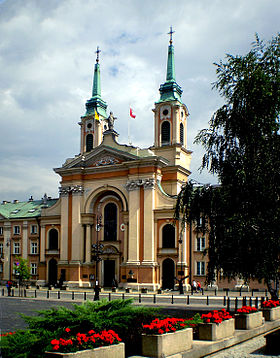Field Cathedral of the Polish Army
| Church of Our Lady Queen of the Polish Crown Katedra Polowa Wojska Polskiego (Polish) |
|
|---|---|

The Field Cathedral, reconstructed after World War II
|
|
| 52°14′56″N 21°0′24″E / 52.24889°N 21.00667°ECoordinates: 52°14′56″N 21°0′24″E / 52.24889°N 21.00667°E | |
| Location | Warsaw |
| Country | Poland |
| Denomination | Roman Catholic |
| History | |
| Founded | 1660 |
| Architecture | |
| Architect(s) | Constantino Tencalla |
| Architectural type | Church |
| Style | Baroque |
| Years built | 1660-1701 |
| Demolished | 1944 |
The Field Cathedral of the Polish Army (Polish: Katedra Polowa Wojska Polskiego, also known as the Church of Our Lady Queen of the Polish Crown) is the main garrison church of Warsaw and the representative cathedral of the entire Polish Army. In the past the church served a variety of communities and roles: it used to be the church of the Collegium Nobilium and in the 19th century was also turned into a Russian Orthodox church. Currently all major military religious feasts in Warsaw are held there.
It is located on Długa Street 13/15, opposite the Heroes of the Warsaw Uprising Monument and Krasiński Square, close to Warsaw's Old Town.
In the 17th century the Piarist friars were given a royal privilege to obtain a large parcel to the west of Warsaw's Old Town. The area, located along the newly paved Miodowa Street, was close to the contemporary city centre, but at the same time offered much more space than in densely populated town. The monks founded the Collegium Nobilium, one of the most notable schools of the epoch and a predecessor to the Warsaw University. In 1660 they also started the construction of a new church that would serve both the students and their teachers, designed most probably by Constantino Tencalla, an Italian architect active in the Polish-Lithuanian Commonwealth at the time.
The church, financed largely by King John Casimir of Poland, was to occupy the place of a former wooden church of Saint Prym and Felicjan, destroyed by the Swedes during the Deluge. However, following the wars with Sweden, Muscovy and the Cossacks, Poland's economy was in ruins and the king's abdication marked an end of the ambitious construction. Because of that, the construction lasted until 1682. The internal works lasted two additional decades and it was not until 1701 that the church was finally consecrated by the bishop of Poznań Mikołaj Święcicki.
...
Wikipedia
